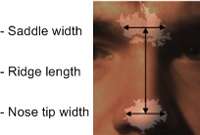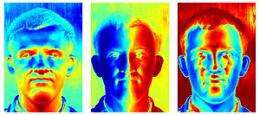Software sniffs out criminals by the shape of their nose

(PhysOrg.com) -- Forget iris and fingerprint scans - scanning noses could be a quicker and easier way to verify a person's identity, according to scientists from the University of the West of England and University of Bath.
With worries about illegal immigration and identity theft, authorities are increasingly looking to using an individual's physical characteristics, known as biometrics, to confirm their identity. Unlike other facial features used for biometrics, such as eyes or ears, noses are difficult to conceal and also aren't changed much by facial expression.
Dr Adrian Evans and Adrian Moorhouse, University of Bath's Dept of Electronic & Electrical Engineering, and Professor Melvyn Smith and Dr Gary Atkinson from UWE's Machine Vision Laboratory decided to investigate whether images of people's noses could be used to recognise individuals. They used a photographic system called PhotoFace, developed at UWE, to scan the 3D shape of volunteers' noses and used computer software to analyse them according to six main nose shapes: Roman, Greek, Nubian, Hawk, Snub and Turn-up.
Instead of using the whole shape of the nose, the researchers used three characteristics in their analysis: the ridge profile, the nose tip, and the nasion or section between the eyes at the top of the nose.
Whilst the researchers used a relatively small sample, they found that nose scanning showed good potential for use as a biometric, with a good recognition rate and a faster rate of image processing than with conventional biometric techniques such as whole face recognition.
Dr Evans (University of Bath) said: “Noses are prominent facial features, and yet their use as a biometric has been largely unexplored. We wanted to find out how good they could be at recognising individuals from a database.”There's no one magic biometric - irises are a powerful biometric, but can be difficult to capture accurately and can easily be obscured by eyelids or glasses.
“Noses, however, are much easier to photograph and are harder to conceal, so a system that recognises noses would work better with an uncooperative subject or for covert surveillance.”
-

The system takes several photos lit with a flash from different angles, throwing shadows on the face -

The software analyses the shadows and works out coordinates for each point on the face
Professor Melvyn Smith led the team at the University of the West of England who developed the PhotoFace system.
He said: “This collaborative project with Bath is very exciting work with great potential. PhotoFace is an innovative 3D face data capture system developed as part of an EPSRC funded project involving UWE, Imperial College, the Home Office (Scientific Development Branch) and General Dynamics Ltd.
"It works by taking photos lit by a flash from several different angles so that four images are taken in very rapid succession of every point on the face, each under different controlled lighting conditions.
“The technique is known as photometric stereo and UWE's Machine Vision Laboratory are one of only three UK centres with expertise in this area. The software then works out the colour, surface orientation and depth of each point on the face by analysing the shading within each of the photos.
"The technique is able to achieve a level of detail that is beyond current competing technologies and can be extended to a myriad of other applications, ranging from industrial surface inspection to cosmetics."
The researchers plan in the future to build up a larger database of noses to test and refine the software to see if it can pick out individuals from a larger group of people, or distinguish between relatives from the same family.
Provided by University of the West of England

















